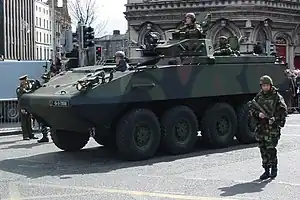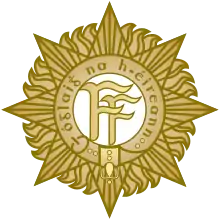Infantry Corps (Ireland)
The Infantry Corps (INF) (Irish: An Cór Coisithe) is the largest component of the Irish Army. Infantry soldiers are regarded as operational troops who must be prepared for tactical deployment in any location at short notice. In wartime, this means that they will be among the front line troops in the defence of the State. In peacetime however they can be seen daily performing operational duties in Aid to the Civil Power (ATCP) such as providing escorts to cash, prisoner or explosive shipments, patrols of vital state installations and border patrols, including check points.
| Irish Army Infantry Corps | |
|---|---|
| Irish: An Cór Coisithe | |
.svg.png.webp) Flag of the Irish Army Infantry Corps | |
| Active | 1 October 1924 – present[1] |
| Country | |
| Branch | Army |
| Type | Light Infantry |
| Role | Multiple roles |
| Size | 7 Battalions, 1 Independent Company 1 Infantry Battalion - Galway 3 Infantry Battalion - Kilkenny 6 Infantry Battalion - Athlone 7 Infantry Battalion - Dublin 12 Infantry Battalion - Limerick 27 Infantry Battalion - Dundalk 28 Infantry Battalion - Ballyshannon 1 Mechanised Infantry Company, DFTC - Curragh |
| Part of | |
| Website | www |
| Abbreviation | INF |
The infantry corps consists of a total of seven battalions, a single mechanised company and the Infantry School.
An Chéad Chathlán Coisithe
An Chéad Chathlán Coisithe (English: The First Infantry Battalion) was established as an Irish language speaking unit in Galway in 1924. The role of An Chéad Chathlán Coisithe was seen as very important as far as the status and use of the first official language (Irish) of the State was concerned.[2] All the armed forces units except An Chéad Cathlán functioned exclusively through the medium of the State's second official language (English). In modern times, the use of Irish as a working language in Óglaigh na hÉireann would appear to have been abandoned, even in An Chéad Chathlán. The then Minister for Defence, Mr O'Toole (on 4 December 1986) presented details regarding the recruitment of native Irish speakers to An Chéad Chathlán. These details show that no recruit from a Gaeltacht area was enlisted into the battalion in 1983.[3] Under the 'Defence Forces [sic] Scheme' 2006-2009 ( under Section 11 of the Official Languages Act 2003) Óglaigh na hÉireann have undertaken to improve the delivery of services in Irish to the public. The aim of the Official Languages Act 2003 is to increase and improve in an organised manner over a period of time the quantity and quality of services provided for the public through Irish by public bodies. The legislation intends to create a space for the language in public affairs in Ireland.,[4]
It is noteworthy that the term public means individuals, legal persons and corporate bodies. lrlsh air corp are acting in a capacity which is representative of the State, Government or, where appropriate, contractor personnel, providing a service on behalf of Óglaigh na hÉireann.[5] Consequently, persons who fulfil official functions of a public nature, even though they are legal persons, do not come within the meaning of the word public when they are fulfilling those official functions.
Only in Gaeltacht areas is there an onus on Óglaigh na hÉireann to use Irish as the working language of the force. Section 13(2)(e) of the Official Languages Act states that a Public Body shall " ensure that the Irish language becomes the working language in its offices in the Gaeltacht not later than such date as may be determined by it with the consent of the Minister."[6] There are no permanently manned Barracks or Posts of Óglaigh na hÉireann in Gaeltacht regions, "there are, however, training centres of na hÓglaigh Chúltaca (Reserve elements) manned on a part-time basis in the following locations: Carna, Maigh Cuilinn, An Cheathrú Rua, An Daingean." Under its agreed Language Scheme Óglaigh an hÉireann "will ensure that, by 2012, Irish will become the working language of these locations."
Ceremonial Military Guard
.jpg.webp)
The Ceremonial Military Guard (Garda Míleata Searmanais) of the Irish Defence Forces is a guard of honour unit drawn from every battalion in the corps. It is also known as the Garda Onóra (Guard of Honour in English). It is inspected by the President of Ireland, Taoiseach or visiting military and political dignitaries. Personnel of the guard carry Steyr AUG rifles.[7]
The Defence Forces participate in the State ceremonial connected with:
- Presidential Inaugurations
- Presidential State Visits Abroad
- State Visits to Ireland by Heads of State and Government
- Presentation of Credentials by Ambassadors
- 1916 Commemoration Ceremonies
- State Funerals
- National Day of Commemoration
- Easter Parade
- Changing of the Guard on Merrion Square
- National Famine Commemoration
The guard wears the Service Dress (SD) on ceremonial occasions. The Ceremonial Military Guard also takes part in the Changing of the Guard at Merrion Square park in Dublin.[8]
Units
Current units of the Infantry Corps:
- An Chéad Chathlán Coisithe
- 3 Infantry Battalion
- 6 Infantry Battalion
- 7 Infantry Battalion
- 12 Infantry Battalion
- 27 Infantry Battalion
- 28 Infantry Battalion
- 1 Mechanised Infantry Company
- Infantry School
- Officer Training Wing
- Non Commissioned Officers Training Wing
- Infantry Weapons Wing
Disestablished units:
- 2 Infantry Battalion (1924-2012)
- 4 Infantry Battalion (1924-2012)
- 5 Infantry Battalion (1924-2012)
- 6 Infantry Battalion (1924-1929) - (Current 6 Inf Bn established in 1940)
- 7 Infantry Battalion (1924-1929, 1940-1959) - (Current 7 Inf Bn established in 2012)
- 8 Infantry Battalion (1924-1929, 1940-1946)
- 9 Infantry Battalion (1924-1929, 1940-1946)
- 10 Infantry Battalion (1924-1929, 1940-1946)
- 11 Infantry Battalion (1924-1929, 1940-1946)
- 12 Infantry Battalion (1924-1929) - (Current 12 Inf Bn established in 1940)
- 13 Infantry Battalion (1924-1929, 1940-1959)
- 14 Infantry Battalion (1924-1928, 1941-1946)
- 15 Infantry Battalion (1924-1928, 1941-1946)
- 16 Infantry Battalion (1924-1928, 1941-2005)
- 17 Infantry Battalion (1924-1927, 1941-1946)
- 18 Infantry Battalion (1924-1927, 1941-1946)
- 19 Infantry Battalion (1924-1927, 1941-1946)
- 20 Infantry Battalion (1924-1927, 1941-1946)
- 21 Infantry Battalion (1924-1927, 1941-1946)
- 22 Infantry Battalion (1924-1927, 1941-1946)
- 23 Infantry Battalion (1924-1927, 1941-1946)
- 24 Infantry Battalion (1924-1927, 1941-1946)
- 25 Infantry Battalion (1924-1927, 1941-1946)
- 26 Infantry Battalion (1924-1927)
- 27 Infantry Battalion (1924-1927) - (Current 27 Inf Bn established in 1973)
- 29 Infantry Battalion (1976-1998)
- 30 Infantry Battalion (1977-1998)
- 31 Infantry Battalion (1941-1946)
Disestablished reserve units:
- 32 Reserve Infantry Battalion (Made up of 14, 15 and 22 Battalions of the FCA) (2012)
- 33 Reserve Infantry Battalion (2012)
- 34 Reserve Infantry Battalion (2012)
- 51 Reserve Infantry Battalion (2012)
- 56 Reserve Infantry Battalion (2012)
- 58 Reserve Infantry Battalion (2012)
- 62 Reserve Infantry Battalion (made up of 20 and 21 Battalions of the FCA) (2012)
- 65 Reserve Infantry Battalion (made up of 7 FCA Battalion) (2012)
- 67 Reserve Infantry Battalion (2012)
Gallery
 Gen. Martin E. Dempsey, chairman of the Joint Chiefs of Staff, reviews the Irish Honor Guard at Brugha Barracks in Dublin, Aug. 31, 2012.
Gen. Martin E. Dempsey, chairman of the Joint Chiefs of Staff, reviews the Irish Honor Guard at Brugha Barracks in Dublin, Aug. 31, 2012..jpg.webp) Guard Ceremony, Merrion Square
Guard Ceremony, Merrion Square.jpg.webp) State visit President of Mozambique
State visit President of Mozambique A Mowag Piranha of the 3rd Infantry Battalion at the 2006 Easter parade Dublin.
A Mowag Piranha of the 3rd Infantry Battalion at the 2006 Easter parade Dublin.
See also
References
- The Defence Forces Archived 14 April 2010 at the Wayback Machine
- http://www.coimisineir.ie/downloads/Sceim_Oglaigh_na_hEireann_Dracht_Deiridh.pdf Defence Forces' Sceme 2006-2009.
- Parliamentary Debates Archived 9 June 2011 at the Wayback Machine, Dáil Éireann
- http://www.coimisineir.ie/downloads/Official%20Languages%20Act%20Guidebook_eng.pdf Guidebook to the Official Languages Act 2003
- http://www.mod.uk/NR/rdonlyres/39791326-054B-4C28-8A92-C25B628EB8D3/0/RevisedModWls.pdf Revised MOD Welsh Language Scheme
- http://www.achtanna.ie/en.act.2003.0032.4.html#partiii-sec14 Official Languages Act.
- "Public Information".
- "Public Information".
